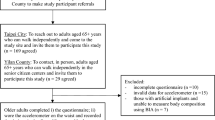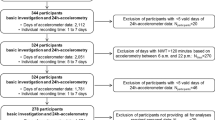Abstract
Introduction:
The International Physical Activity Questionnaire (IPAQ) was developed to measure health-enhancing physical activity in adult populations. This study explores the concurrent validity of a modified version of the long IPAQ (the IPAQ-A) for the assessment of physical activity among adolescents.
Participants and methods:
In total, 248 healthy adolescents, divided into one older and one younger age group (aged 15–17 years (N=188) and 12–14 years (N=60), respectively) from nine Healthy Lifestyle by Nutrition in Adolescence (HELENA) Study centres across Europe, voluntarily participated in the study. Data on total physical activity, as well as activities in different intensities derived from the IPAQ-A, were compared using Spearman's correlation coefficient and Bland–Altman analysis, with data from an accelerometer. Tertiles of total physical activity for the IPAQ-A and the accelerometer were compared using Kendall's tau-b.
Results:
For the older age group, significant correlations between the instruments were found for time spent walking, for moderate and vigorous activities as well as for total physical activity (Rs=0.17–0.30, P<0.05). No significant correlations were found for any of the variables studied in the younger age group. Kendall's tau-b showed low but significant correlations for tertiles of total physical activity (P<0.001).
Conclusions:
The IPAQ-A has reasonable validity properties for assessing activities in different intensities and for total physical activity in healthy European adolescents aged 15–17 years. For adolescents aged 14 years and younger, the correlations were unsatisfactorily low and objective methodology, such as accelerometry, may be the appropriate alternative.
This is a preview of subscription content, access via your institution
Access options
Subscribe to this journal
Receive 12 print issues and online access
$259.00 per year
only $21.58 per issue
Buy this article
- Purchase on Springer Link
- Instant access to full article PDF
Prices may be subject to local taxes which are calculated during checkout



Similar content being viewed by others
References
CDC. Physical Activity and Health. A Report from the Surgeon General. CDC: Pittsburg, 1996.
Pedersen BK, Saltin B . Evidence for prescribing exercise as therapy in chronic disease. Scand J Med Sci Sports 2006; 16 (Suppl 1): 3–63.
Brown W, Bauman A, Chey T, Trost S, Mummery K . Comparison of surveys used to measure physical activity. Aust N Z J Public Health 2004; 28: 128–134.
WHA. World Health Assembly 57.17. Global Strategy on diet, physical activity and health, 2004, pp 1–4.
Moreno LA, González-Gross M, Kersting M, Molnár D, de Henauw S, Beghin L et al. Assessing, understanding and modifying nutritional status, eating habits and physical activity in European adolescents. The HELENA study. Public Health Nutr 2008; 6: 288–299.
Aarnio M, Winter T, Kujala U, Kaprio J . Associations of health related behaviour, social relationships, and health status with persistent physical activity and inactivity: a study of Finnish adolescent twins. Br J Sports Med 2002; 36: 360–364.
IPAQ. The International Physical Activity Questionnaire, http://www.ipaq.ki.se/.
Craig C, Marshall AL, Sjostrom M, Bauman AE, Booth ML, Ainsworth BE et al. International physical activity questionnaire: 12-country reliability and validity. Med Sci Sports Exerc 2003; 35: 1381–1395.
Barnett J, Nigg CR, De Bourdeaudhuij I, Maglione C, Maddock J . The effect of item order on physical activity estimates using the IPAQ. Californian J Health Promot 2007; 5: 23–29.
ACSM. American College of Sports Medicine Position Stand. The recommended quantity and quality of exercise for developing and maintaining cardiorespiratory and muscular fitness, and flexibility in healthy adults. Med Sci Sports Exerc 1998; 30: 975–991.
Ainsworth BE, Haskell WL, Leon AS, Jacobs Jr DR, Montoye HJ, Sallis JF et al. Compendium of physical activities: classification of energy costs of human physical activities. Med Sci Sports Exerc 1993; 25: 71–80.
Ainsworth BE, Haskell WL, Whitt MC, Irwin ML, Swartz AM, Strath SJ et al. Compendium of physical activities: an update of activity codes and MET intensities. Med Sci Sports Exerc 2000; 32: S498–S504.
Computer Science Application. Activity Monitor Operator's Manual. In: Shallimar FL (ed). Model 7164 version AM7164;2-2, 1995, pp 3–24.
Trost SG, Ward DS, Moorehead SM, Watson PD, Riner W, Burke JR . Validity of the computer science and applications (CSA) activity monitor in children. Med Sci Sports Exerc 1998; 30: 629–633.
Trost SG, Pate RR, Freedson PS, Sallis JF, Taylor WC . Using objective physical activity measures with youth: how many days of monitoring are needed? Med Sci Sports Exerc 2000; 32: 426–431.
Altman D . Practical Statistics for Medical Research. Chapman & Hall: London, 1991.
Atkinson G, Nevill AM . Statistical methods for assessing measurement error (reliability) in variables relevant to sports medicine. Sports Med 1998; 26: 217–238.
Sirard JR, Pate RR . Physical activity assessment in children and adolescents. Sports Med 2001; 31: 439–454.
Welk G . Physical Assessment in Health-Related Research. Human Kinetics: Leeds, UK, 2002.
Washburn RA, Heath GW, Jackson AW . Reliability and validity issues concerning large-scale surveillance of physical activity. Res Q Exerc Sport 2000; 71: S104–S113.
Bassett Jr DR . Validity and reliability issues in objective monitoring of physical activity. Res Q Exerc Sport 2000; 71: S30–S36.
Sirard JR, Melanson EL, Li L, Freedson PS . Field evaluation of the Computer Science and Applications, Inc. physical activity monitor. Med Sci Sports Exerc 2000; 32: 695–700.
Hendelman D, Miller K, Baggett C, Debold E, Freedson P . Validity of accelerometry for the assessment of moderate intensity physical activity in the field. Med Sci Sports Exerc 2000; 32: S442–S449.
Ekelund U, Yngve A, Sjostrom M, Westerterp K . Field evaluation of the Computer Science and Application's Inc. Activity monitor during running and skating training in adolescent athletes. Int J Sports Med 2000; 21: 586–592.
Ainsworth BE, Bassett Jr DR, Strath SJ, Swartz AM, O’Brien WL, Thompson RW et al. Comparison of three methods for measuring the time spent in physical activity. Med Sci Sports Exerc 2000; 32: S457–S464.
Nichols JF, Morgan CG, Chabot LE, Sallis JF, Calfas KJ . Assessment of physical activity with the Computer Science and Applications, Inc. accelerometer: laboratory versus field validation. Res Q Exerc Sport 2000; 71: 36–43.
Yngve A, Nilsson A, Sjostrom M, Ekelund U . Effect of monitor placement and of activity setting on the MTI accelerometer output. Med Sci Sports Exerc 2003; 35: 320–326.
Caspersen CJ, Nixon PA, DuRant RH . Physical activity epidemiology applied to children and adolescents. Exerc Sport Sci Rev 1998; 26: 341–403.
Crocker PR, Bailey DA, Faulkner RA, Kowalski KC, McGrath R . Measuring general levels of physical activity: preliminary evidence for the Physical Activity Questionnaire for Older Children. Med Sci Sports Exerc 1997; 29: 1344–1349.
Wong SL, Leatherdale ST, Manske SR . Reliability and validity of a school-based physical activity questionnaire. Med Sci Sports Exerc 2006; 38: 1593–1600.
McMurray RG, Ring KB, Treuth MS, Welk GJ, Pate RR, Schmitz KH et al. Comparison of two approaches to structured physical activity surveys for adolescents. Med Sci Sports Exerc 2004; 36: 2135–2143.
Acknowledgements
The HELENA Study was carried out with the financial support of the European Community Sixth RTD Framework Programme (Contract FOOD-CT-2005-007034) and of the Stockholm County Council. The content of this paper reflects only the authors’ views, and the European Community is not liable for any use that may be made of the information contained therein. FBO is supported by CSD (Ref: 109/UPB31/03 and 13/UPB20/04) and the FPU-Spanish Ministry of Education (Ref: AP-2004-2745) grants. J Pablo Rey Lopez is supported by Fundacion Cuenca Villoro. The researchers from the University of Zaragoza, Spain (JPRL) are complementarily supported by FUNDACIÓN MAPFRE (Spain). We thank the adolescents for their participation. A copy of the modified IPAQ questionnaire can be downloaded from the HELENA website.
Author information
Authors and Affiliations
Consortia
Corresponding author
Additional information
Conflict of interest
The authors state no conflict of interest.
Rights and permissions
About this article
Cite this article
Hagströmer, M., Bergman, P., De Bourdeaudhuij, I. et al. Concurrent validity of a modified version of the International Physical Activity Questionnaire (IPAQ-A) in European adolescents: The HELENA Study. Int J Obes 32 (Suppl 5), S42–S48 (2008). https://doi.org/10.1038/ijo.2008.182
Published:
Issue Date:
DOI: https://doi.org/10.1038/ijo.2008.182
Keywords
This article is cited by
-
Assessing the relationship between food insecurity and lifestyle behaviors among university students: a comparative study between Lebanon and Germany
BMC Public Health (2023)
-
Lifestyle behaviors, metabolic disturbances, and weight gain in psychiatric inpatients treated with weight gain-associated medication
European Archives of Psychiatry and Clinical Neuroscience (2023)
-
Association between adherence to the EAT-Lancet sustainable reference diet and cardiovascular health among European adolescents: the HELENA study
European Journal of Clinical Nutrition (2023)
-
Daily Physical Activity and Satisfaction with Life in Adolescents: An Ecological Momentary Assessment Study Exploring Direct Associations and the Mediating Role of Core Affect
Journal of Happiness Studies (2022)
-
Walking and cycling, as active transportation, and obesity factors in adolescents from eight countries
BMC Pediatrics (2022)



